Measuring Regional Capacity for Innovation
Innovation is a key ingredient in an economy’s ability to increase the standard of living for a region’s residents. Building on other national and European research, a newly released Innovation Index (www.statsamerica.org/innovation) provides policymakers and economic development practitioners with a unique web-based tool for exploring regional innovation performance and comparing that with the United States, a state or other regions.1
First Things First: What Is Innovation?
Our research focused on this definition: Innovation puts ideas into action with the result of increasing firms’ compensation and profits.2 Innovation can result in the introduction of new or better goods and services and is manifest in adopting new technologies and processes that increase productivity or lower costs. Adopting a new technology makes production more efficient. Adopting new business models and organizational structures improve how firms meet consumer needs, process information or make decisions. As a result, innovation reduces costs and increases profitability. Innovation can be incremental (e.g., reducing breakage during shipping) or radical (e.g., using computers for business applications). On a more macro-level, innovation is evident in an economy that is adaptable and that can readily move resources from lower value-added activities to higher value-added activities.
Creating the Index
Combining multiple variables into a composite index provides a single, high-level snapshot to evaluate innovative capacity, innovation outcomes and economic progress (see Figure 1).3 The indicators in the Innovation Index are derived from both official government statistical agencies and several private, proprietary sources, including Economic Modeling Specialists, Inc., Innovation Economy 360 and Moody’s economy.com.
Figure 1: The County-Level Innovation Index for the United States
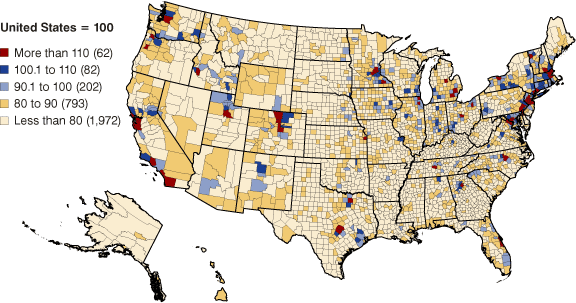
Source: Indiana Business Research Center
The index includes both inputs and outputs together as a composite indicator of innovation capacity and output potential. Inputs are those factors, influences or conditions that promote innovation. Inputs are divided into two sub-indexes: human capital and economic dynamics.
- Human Capital: These variables suggest the extent to which a county’s population and labor force are able to engage in innovative activities. Counties with high levels of human capital are those with enhanced knowledge that can be measured by high educational attainment, growth in younger age brackets of the workforce (signifying attractiveness to younger generations of workers), and a sizeable number of innovation-related occupations and jobs relative to the overall labor force.
- Economic Dynamics: These variables measure local business conditions and resources available to entrepreneurs and businesses. Targeted resources such as research and development funds are input flows that encourage innovation close to home, or that, if not present, can limit innovative activity.
Outputs are the direct outcomes and economic improvements that result from inputs. These are divided into two sub-indices: productivity and employment, and economic well-being.
- Productivity and Employment: These variables describe economic growth, regional desirability or direct outcomes of innovative activity. Variables in this index suggest the extent to which local and regional economies are thriving and attracting workers seeking particular jobs.
- Economic Well-Being: Innovative economies improve economic well-being because residents earn more and have a higher standard of living. Decreasing poverty rates, increasing employment, in-migration of new residents and improvements in personal income signal a more desirable location to live and point to an increase in economic well-being.
Figure 2 shows the individual indicators in each sub-index, along with how each sub-index is weighted in the calculation of the overall index.4
Figure 2: Indicators and Weights Used to Calculate the Innovation Index
Human Capital: 30%
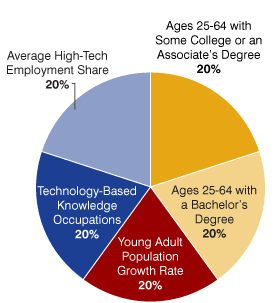
Economic Dynamics: 30%
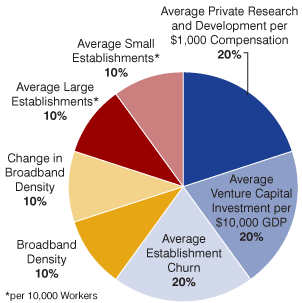
Productivity and Employment: 30%
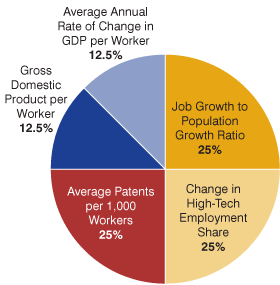
Economic Well-Being: 10%
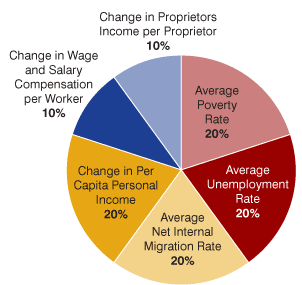
Source: Indiana Business Research Center
A fifth sub-index, state context, seeks to capture data that are theoretically important but available only at the state level (therefore, it is not used for the index calculation). It is composed of science and engineering graduates from state institutions per 1,000 residents of the state and research and development spending per capita.
So What Does This Mean? Interpreting the Index
Each region of the country has a different mix of qualities that can boost its overall innovation score. No two counties or regions will be exactly alike and there is no single path toward an innovative and growing economy.
Interpretation of this index should be done with some caution. While the collection of multiple data points into a single composite estimate provides an efficient way of visualizing and comparing innovation capacity, it can obscure information that could help explain a particular region’s underlying innovative capacity and performance.
To illustrate that point, within Indiana, four counties (out of 92) exceed the U.S. average on the overall index (see Table 1). Kosciusko and Hamilton counties both scored quite highly on the productivity and employment sub-index but for different reasons.
Table 1: Indiana Counties Scoring above 100 on the Innovation Index
| County | Innovation Index | Productivity and Employment Sub-Index | Economic Well-Being Sub-Index | Human Capital Sub-Index | Economic Dynamics Sub-Index |
| Kosciusko | 107.8 | 122.5 | 99.7 | 102.1 | 101.6 |
| Hamilton | 103.5 | 122.8 | 97.6 | 113.0 | 76.7 |
| Marion | 101.9 | 94.3 | 101.6 | 104.1 | 107.4 |
| Bartholomew | 100.2 | 109.4 | 98.0 | 83.4 | 108.4 |
Source: Indiana Business Research Center
Those reasons can be seen in Table 2, which compares the productivity and employment indicators for Kosciusko and Hamilton counties. Kosciusko’s high value on this sub-index is driven by change in high-tech employment, change in GDP per worker, and patents per worker (because they all exceed the U.S. average). Conversely, Hamilton County’s high value is due only to a very high value for patents per worker.
Table 2: Productivity and Employment Indicators
| Indicator | United States | Kosciusko County | Hamilton County |
| Rate of Change in High-Tech Employment Share, 1997-2006 | -0.7% | 3.9% | -2.0% |
| Job Growth-to-Population Growth Ratio, 1997-2006 | 0.73 | 0.72 | 0.65 |
| Gross Domestic Product per Worker, 2006 | $73,783 | $72,121 | $60,213 |
| Average Rate of Change in GDP per Worker, 1997-2006 | 3.7% | 4.4% | 2.6% |
| Average Patents per 1,000 Workers, 1997-2006 | 0.94 | 1.55 | 2.62 |
Source: Indiana Business Research Center
There is no perfect combination of factors that define an innovative region, but an innovative county could be expected to perform at or better than the nation in at least one category. In Indiana, 28 counties (30 percent) score greater than 100 in at least one input or output sub-index (see Table 3).
Table 3: Indiana Counties Scoring above 100 on at Least One Sub-Index
| County | Innovation Index | Human Capital | Economic Dynamics | Productivity and Employment | Economic Well Being |
| Kosciusko | 107.8 | 102.1 | 101.6 | 122.5 | 99.7 |
| Hamilton | 103.5 | 113 | 76.7 | 122.8 | 97.6 |
| Marion | 101.9 | 104.1 | 107.4 | 94.3 | 101.6 |
| Bartholomew | 100.2 | 83.4 | 108.4 | 109.4 | 98 |
| Tippecanoe | 97.2 | 101 | 82.2 | 108.7 | 96.5 |
| Posey | 96.3 | 96.9 | 71.1 | 120.9 | 96.4 |
| Monroe | 94.6 | 122.6 | 71.1 | 90.2 | 94.8 |
| Boone | 94.4 | 84.9 | 69.6 | 123.3 | 110.4 |
| Hancock | 94.4 | 98.2 | 78.9 | 104 | 100.6 |
| Ripley | 93 | 73.3 | 79.4 | 125.2 | 96.1 |
| Morgan | 91.4 | 80.2 | 84.7 | 106.6 | 98.9 |
| Tipton | 90.7 | 70.4 | 71.6 | 129.4 | 92.4 |
| Franklin | 90.6 | 68 | 97.2 | 105.1 | 95.3 |
| Johnson | 90.1 | 90 | 76.4 | 101.4 | 97.6 |
| Dearborn | 89.7 | 72.9 | 82.8 | 110.7 | 97.5 |
| Howard | 88.8 | 79.6 | 77.1 | 108.7 | 91.6 |
| Owen | 88.6 | 74.4 | 79.9 | 108.4 | 98.2 |
| Warrick | 88.4 | 83.8 | 76.5 | 100.6 | 101.2 |
| Gibson | 88.3 | 103.1 | 67.5 | 90 | 100.6 |
| Floyd | 87.4 | 84.8 | 80.9 | 92 | 101 |
| St. Joseph | 86.1 | 92.3 | 73.2 | 87.4 | 102 |
| Vanderburgh | 85.6 | 92.1 | 75.7 | 83.4 | 102.2 |
| Hendricks | 84.7 | 82.6 | 71.1 | 94.8 | 101.8 |
| Putnam | 82.5 | 75.2 | 84.4 | 81.9 | 100.7 |
| Dubois | 82.5 | 72.7 | 89.7 | 78.3 | 102.5 |
| Jackson | 81.9 | 76.7 | 82.7 | 79.7 | 101.9 |
| Spencer | 78.9 | 67.9 | 69.8 | 91.3 | 101.8 |
| Union | 78.4 | 71.4 | 49.1 | 107.5 | 99.6 |
| Total above 100 | 4 | 6 | 3 | 17 | 13 |
Note: Shaded cells indicate values above the U.S. average (i.e., greater than 100).
Source: Indiana Business Research Center
Conclusion
The Innovation Index can serve as a valuable tool for policymakers and practitioners to quickly evaluate innovative capacity and potential. As with all indices, however, the overall estimate is not as important as the sum of its parts. Economic development practitioners not only get a quick snapshot of how their region is doing in terms of innovation with the portfolio index, but they also have the ability to drill down into the highly granular data to gain a better understanding about their region’s strengths and weaknesses.
Upcoming articles will discuss innovation in Indiana’s regions, as well as ongoing empirical research. In the meantime, visit www.statsamerica.org/innovation/ to begin using the Innovation Index.
Notes
- This research was supported by a generous grant from the U.S. Economic Development Administration and done in collaboration with Purdue Center for Regional Development, Strategic Development Group,Inc., the Rural Policy Research Institute, and Economic Modeling Specialists, Inc.
- The vast majority of value added is comprised of compensation and profits. In economics, value added refers to the returns on the factors of production—primarily labor and capital—that increase the value of a product and corresponds to the incomes received by labor and the owners of capital.
- This approach is similar to the annual European Innovation Scorecard: http://ecfr.eu/scorecard/home.
- A discussion of the rationale behind the variable selection is at www.statsamerica.org/innovation/innovation_index/methodology.html.
Timothy F. Slaper, Ph.D.
Director of Economic Analysis, Indiana Business Research Center, Indiana University's Kelley School of Business
Rachel Justis
Geodemographic Analyst, Indiana Business Research Center, Indiana University's Kelley School of Business
